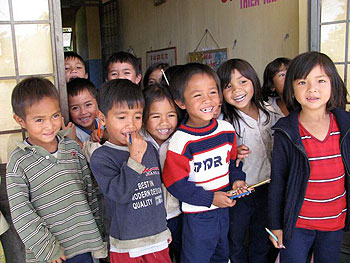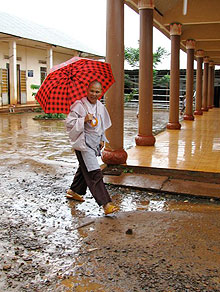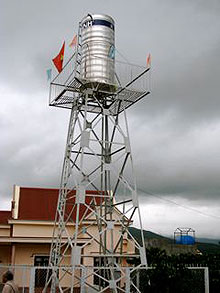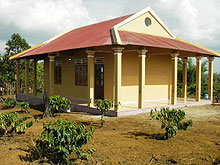
Giggly schoolchildren rush to meet visitors at recess.

Northwesterners in Vietnam:
Compassion in Action
She strides across the bare earth between the dormitories and the classroom holding an umbrella against the sudden squall, her brown robes flying behind her. Puddles don’t deter her. Flip-flops swiftly off, she steps into each successive schoolroom, Her smile is like the sun coming out as she greets each of the teachers and the children who are quietly settling into their seats after lunch. Then she’s off to speak to the half dozen workmen who are building an addition to the temple pagoda, all with hand tools.

Buddhist nun Thich Nu Hue Huong, head administrator of Buu Thang Pagoda school and orphanage and "true Bodhisattva."
Only then does she approach the entrance to welcome us with outstretched arms and a radiance that warms us instantly. This is Thich Nu Hue Huong, a Buddhist nun, head administrator of Buu Thang Pagoda school and orphanage, 20 miles outside of Buon Ma Thuot in the Central Highlands of Vietnam. Over a delicious vegetarian lunch we learn that, in addition to her temple duties, she raises money for books and clothes for each orphan teenager who wants to go to college. She is indefatigable, manifesting an inner peace and joy that is contagious.
To me she embodies the human symbol of a compassionate life being lived fully, moment to moment. A true Bodhisattva.
I traveled in Vietnam for three weeks in November with a small group involved with Care To Help, a Seattle nonprofit, (www.caretohelp.org), headed by Scott Mantz, a landscape architect and Yen Ngo, a Seattle University counselor, who initiated the CTH Project six years ago. They went to Vietnam, wanting to see the “real” villages off the tourist trail and met a John Wayne fan, Mr. Viet Hung, who agreed to take them into the more remote areas. There they found many people ill from drinking polluted ground water. Children did not go to school even when there was one, because they were too ill. They realized that these people did not need money; they needed good health first; they needed good water.

One of Care to Help's donated water towers.
So, Scott and Yen, who take no money for themselves, founded Care To Help, and, with Mr. Hung’s on-the-spot enthusiastic management, have drilled and maintained 20 wells, each at least 300 feet deep, in various villages, providing clean health-giving water for between eight to ten thousand people. They have raised enough money to build five schools and an orphanage, as well. Since one of our dollars amounts to 16,000 of theirs, American money goes a long way for the Vietnamese.
We—12 Americans in all, two of whom spoke Vietnamese—traveled with Mr. Hung to see how the children are, how well the wells are working, and what the health of the villagers is now. As a visual answer, we saw mothers and babies at the well, merry children playing in abundant water and studying hard in school, small garden patches being watered. Village craftsmen and women—basket makers, weavers—making beautiful, useful things after long hours in the rice or corn or coffee fields. Every tiny bit of land was growing vegetables, healthy vegetables watered with clear water. Ducks, pigs, dogs wandered about. Vital, exuberant teachers at the schools and assistant nuns at the orphanage welcomed us to meet children ranging in age from a few months to teenagers, with whom we fell in love instantly. Smiling, kind people greeted us every day in clean colorful villages of amazing diversity.

The new school, completed in 40 days.
Vietnam is long (about 2,800 miles) and skinny (only 30 miles wide at the center), a country of staggering beauty, whether it’s in the mountains or along creamy crescent beaches. The Vietnamese tell us that they do not carry past misfortunes; they are hopeful and ready, as they say, to move on. We never sensed animosity for our country’s part in “The American War.” Does this kind forgiveness stem from their Buddhist heritage? I wondered.
While we were there, my son, Duncan Berry, a student of Thich Nhat Hahn’s, went to one of the Zen master’s large monasteries and, with the encouragement of the head abbot, agreed to build a school within the temple compound for minority local children for whom there was no nearby school. With characteristic speed, the new, tile-built school opened its doors to the children in a record 40 days to completion. Compassion in action, indeed.
Contributor: Kajira Wyn Berry
Photos: Kajira Wyn Berry